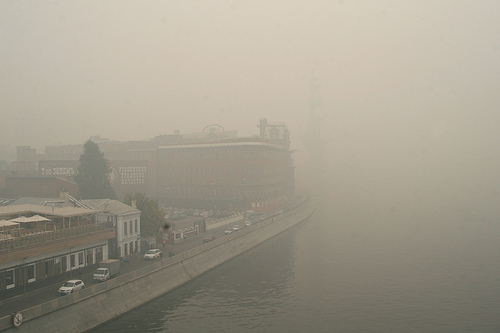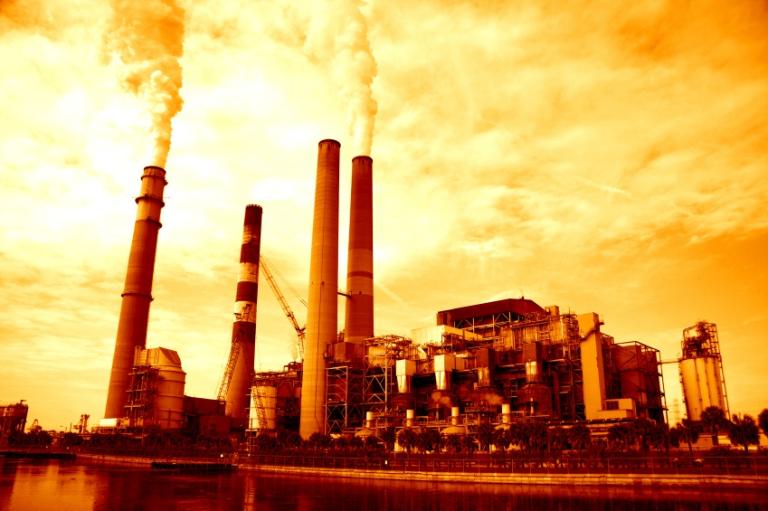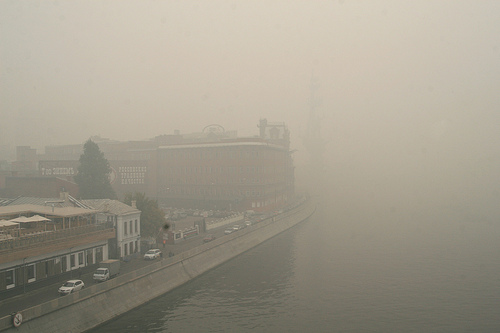 Smog and heat hang over Moscow.Photo courtesy of Lvovsky via flickr
Smog and heat hang over Moscow.Photo courtesy of Lvovsky via flickr
Cross-posted from the Wonk Room.
As Russia chokes from a heat wave of unprecedented ferocity, president Dmitry Medvedev has strengthened his call for the world’s leaders to take action to fight global warming pollution. The scientific community has warned for decades that burning coal and oil without limit would intensify heat waves, droughts, and floods. Now that the planet is at its hottest in recorded history, freak climate disasters are arriving with increasing frequency. Some scientists are now stating the obvious: Russia’s heat wave simply would not have happened without the influence of fossil fuel pollution on our atmosphere. University of Texas climate scientist Michael Tobis is “hazarding a guess” that “the Russian heat wave of 2010 is the first disaster unequivocally attributable to anthropogenic climate change”:
But right now I feel like hazarding a guess. As far as I understand, nothing like this has happened before in Moscow … The formerly remarkable heat wave of 2001, then, is “the sort of thing we’ll see more of” with global warming. But it may turn out reasonable, in the end, to say “the Russian heat wave of 2010 is the first disaster unequivocally attributable to anthropogenic climate change.”
Meteorologist Rob Carver, the Research and Development Scientist for Weather Underground, agrees. Using a statistical analysis of historical temperature records, Dr. Carver estimates that the likelihood of Moscow’s 100-degree record on July 29 is on the order of once per 1,000 years, or even less than once every 15,000 years — in other words, a vanishingly small probability. However, those tiny odds are based on the assumption that the long-term climate is stable, an assumption that is no longer true.
Like Dr. Tobis, Carver believes that manmade global warming has fundamentally altered weather patterns to produce the killer Russian heat wave. “Without contributions from anthropogenic climate change,” Carver said in an email interview with the Wonk Room, “I don’t think this event would have reached such extremes or even happened at all”:
I agree with Michael Tobis’s take at Only In It For the Gold that something systematic has changed to alter the global circulation, and you’ll need a coupled atmosphere/ocean global model to understand what’s going on. My hunch is that a warming Arctic combined with sea-surface-temperature teleconnections altered the global circulation such that a blocking ridge formed over western Russia leading to the unprecedented drought/heat wave conditions. Without contributions from anthropogenic climate change, I don’t think this event would have reached such extremes or even happened at all. (You may quote me on that.)
Just as the Russian heat wave is fueled by global warming, so is the rest of the world’s killer climate. World-renowned climatologist Kevin Trenberth explained in an interview with Wired’s Brandon Keim that the Eurasian heat wave is part of the even larger circulation pattern that has produced the catastrophic southeast Asia monsoon:
The two things are connected on a very large scale, through what we call an overturning or monsoonal circulation. There is a monsoon where upwards motion is being fed by the very moist air that’s going onshore, and there are exceptionally heavy rains. That drives rising air. That air has to come down somewhere. Some of it comes down over the north.
Dr. Rob Carver’s analysis of the statistical likelihood of the Moscow heatwave:
Now, let’s take a look at July 29, when it cracked 100 F at Moscow Shermetyevo. By our records, the reported high was 100 degrees F and the normal high for that day is 68 F. According to GDAS, the maximum temperature for Moscow on July 29 was 96 degrees F and the normal temperature according to CFSR is 69 F. Using the techniques of Hart and Grumm (2001), the climatological anomaly for maximum temperature is 7 degrees F.
So, using the GDAS and CFSR data, the normalized anomaly of maximum temperature was +3.1. That’s near a recurrence interval of once per thousand years which matches the quotes I’ve heard from Russian met agencies. Now, if we assume the climatological anomaly derived from CFSR data is the same of the observations, the normalized anomaly jumps to +4.5, which translates into “less than once every 15,788″.
That however, is a tricky assumption to make. We know that the climatic properties of CFSR and GDAS data have to have some correspondence with what’s actually happens in the atmosphere, otherwise weather models wouldn’t work. What becomes difficult to quantify (in the time constraints of writing for the public) is how the statistics of the climate properties line up between observations and reanalysis. And at these extremes, it doesn’t take much change in the average and standard deviation of a property to dramatically change how unusual an event is. Another possible source of error is the assumption that the climatology of CFSR is the climatology of the operational GDAS. Which is not a slam-dunk since NCEP shifted to a higher-resolution model on July 28. Now, I don’t have any information to say the post July 28 GDAS data has different climatological characteristics, but it’s a possibility. Another big assumption I make is that daily maximum temperatures follow a Gaussian (normal) distribution and that from 30 years of CFSR data, I can adequately characterize such a distribution.



